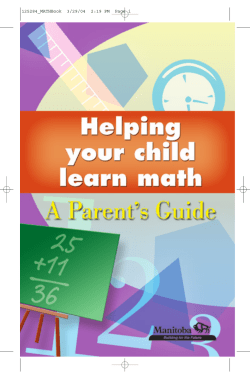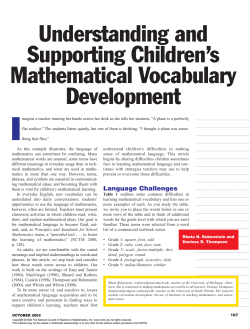
References
References References The following is a list of works that were cited or consulted in the preparation of the TIMSS 2011 Assessment Frameworks. Abadzi, H. (2007, October). Absenteeism and beyond: Instructional time loss and consequences (World Bank Policy Research Working Paper Number 4376). Washington, DC: Author. Akey, T. M. (2006). School context, student attitudes and behavior, and academic achievement: An exploratory analysis. New York: MDRC. American Association for the Advancement of Science. (1993). Benchmarks for science literacy. Oxford, England: Oxford University Press. American Association for the Advancement of Science. (2000). Inquiring into inquiry learning and teaching in science. Washington, DC: Author. American Association for the Advancement of Science. (2001). Designs for science literacy. New York: Author. Bandura, A. (1997). Self-efficacy: The exercise of control. New York: Freeman. Bos, W., Schwippert, K., & Stubbe, T. C. (2007). Die Koppelung von sozialer Herkunft und Schulerleistung im internationalen Vergleich [The linkage of social background and achievement, an international perspective]. In W. Bos, S. Hornberg, K. H. Arnold, G. Faust, L. Fried, E. M. Lankes, K. Schwippert, & R. Valtin (Eds.), IGLU 2006: Lesekompetenzen von Grundschulkindern in Deutschland im internationalen Vergleich (pp. 225-247). Munster: Waxmann. Bradley, R. H., & Corwyn, R. F. ( 2002 ). Socioeconomic status and child development. Annual Review of Psychology, 53, 371-399. Braun, H., Coley, R., Jia, Y., & Trapani, C. (2009, May). Exploring what works in science instruction: A look at the eighth-grade science classroom (ETS Policy Information Report). Princeton, NJ: Educational Testing Service. Bruggenkate, G. C. (2009). Maken schoolleiders het verschil? [Do school leaders make a difference?]. Unpublished doctoral dissertation. University of Twente, Enshede, Netherlands. Butler, L. A. (1997). Building on a dream of success. Principals, 76(5), 28-31. references | 137 Champagne, A. B., Kouba, V. L., & Hurley, M. (2000). Assessing inquiry. In J. Minstrell & E. H. Van Zee (Eds.), Inquiring into inquiry learning and teaching in science (pp. 447 - 470 ). Washington, DC: American Association for the Advancement of Science. Clements, D. H., & Sarama, J. ( 2009). Learning and teaching early math: The learning trajectories approach. New York: Routledge. Clotfelter, C. T., Ladd, H. F., & Vigdor, J. L. (2007 , November). Are teacher absences worth worrying about in the U.S.? (NBER Working Paper No. W13648). Cambridge, MA: Authors. Clotfelter, C. T., Ladd, H. F., & Vigdor, J. L. ( 2006, January). Teacher-student matching and the assessment of teacher effectiveness. (NBER Working Paper No. 11936). Cambridge, MA: Authors. Coley, R. J. (2001, February). Differences in gender gap: Comparisons across racial/ ethnic groups in education and work (ETS Policy Information Report). Princeton, NJ: Educational Testing Service. Cooper, H., Robinson, J. C., & Patall, E. A. ( 2006). Does homework improve academic achievement? A synthesis of research, 1987-2003. Review of Educational Research, 76(1), 1-62. Cotton, K. (2003). Principals and student achievement: What the research says. Alexandria, VA: Association for Supervision and Curriculum Development (ASCD). Darling-Hammond, L. (1996). The right to learn and the advancement of teaching: Research, policy, and practice for democratic education. Educational Researcher, 25(6), 5-17. Darling-Hammond, L. (2006). Constructing 21st-century teacher education. Journal of Teacher Education, 57(3), 300-314. Davies, B. (Ed.). (2009). The essentials of school leadership (2nd ed.). Los Angeles: Sage. Dearing, E., Kreider, H., & Weiss, H. B. (2008). Increased family involvement in school predicts improved child-teacher relationships and feelings about school for low-income children. Marriage & Family Review, 43(3), 226-254. Dee, T. S. (2006). The why chromosome: How a teacher’s gender affects boys and girls. Education Next, 6(4), 68-75. DuFour, R., Eaker, R., & DuFour, R. (2005). Recurring themes of professional learning communities and the assumption they challenge. In DuFour, E., & DuFour, R. (Eds.), On common ground: The power of professional learning communities (pp. 7-29). Bloomington, IN: National Education Service. Epstein, J. L. (2001). School and family partnerships: Preparing educators and improving schools. Boulder, CO: Westview. 138 |references Erberber, E. (2009). Analyzing Turkey’s data from TIMSS 2007 to investigate regional disparities in eighth grade science achievement. Unpublished doctoral dissertation, Boston College, Massachusetts. Ertmer, P. ( 2003 ). Transforming teacher education: Visions and strategies. Educational Technology Research and Development, 51(1), 124-128. Foy, P., Galia, J., & Li, I. (2008). Scaling the data from the TIMSS 2007 mathematics and science assessments. In J. F. Olson, M. O. Martin, & I. V. S. Mullis (Eds.), TIMSS 2007 technical report (pp. 225-279). Chestnut Hill, MA: TIMSS & PIRLS International Study Center, Boston College. Goldhaber, D., & Brewer, D. J. (2000). Does teacher certification matter? High school teacher certification status and student achievement. Educational Evaluation and Policy Analysis, 22(2), 129-145. Gradstein, M., & Schiff, M. (2004, March). The political economy of social exclusion with implications for immigration policy. (IZA Discussion Paper No. 1087). Bonn, Germany: Authors. Greenberg, E., Skidmore, D., & Rhodes, D. (2004, April). Climates for learning: mathematics achievement and its relationship to schoolwide student behavior, schoolwide parental involvement, and school morale. Paper presented at the annual meeting of the American Educational Researchers Association, San Diego, CA. Greenwald, R., Hedges, L. V., & Laine, R. D. (1996). The effect of school resources on student achievement. Review of Educational Research, 66(3), 361-396. Hanushek, E. A., Kain, J. F., O’Brien, D. M., & Rivkin, S. G. (2005, February). The market for teacher quality. (NBER Working Paper No. 11154). Cambridge, MA: Authors. Haveman, R., & Wolfe, B. (2008). The determinants of children’s attainments: A review of methods and findings. Journal of Economic Literature, 33(4), 1829-1878. Henson, R. (2002). From adolescent angst to adulthood: Substantive implications and measurement dilemmas in the development of teacher efficacy research. Educational Psychologist, 37(3), 137–150. Hill, H. C., & Lubienski, S. T. (2007). Teachers’ mathematics knowledge for teaching and school context: A study of California teachers. Educational Policy, 21(5), 747-768. Hill, P. T., & Christensen, J. (2007). Safety and order in charter and traditional public schools. In R. Lake (Ed.) Hopes, fears, and reality. Seattle, WA: Center on Reinventing Public Education. Johansone, I. (2009). Managing primary education in Latvia to assure quality and achievement equity. Unpublished doctoral dissertation, University of Latvia, Riga, Latvia. REferences | 139 Johnson, S. M., Berg, J. H., & Donaldson, M. L. (2005). Who stays in teaching and why: A review of the literature on teacher retention. Cambridge: Harvard Graduate School of Education. Kirsch, I. S., Braun, H., Yamamoto, K., & Sum, A. (2007, January). America’s perfect storm: Three forces changing our nation’s future (ETS Policy Information Report). Princeton, NJ: Educational Testing Service. Klonsky, M. (2002). How smaller schools prevent school violence. Educational Leadership, 59(5), 65-69. Kurtz-Costes, B. E., & Schneider, W. (1994). Self-concept, attributional beliefs, and school achievement: A longitudinal analysis. Contemporary Educational Psychology, 19(2), 199-216. Laffey, J. M., Espinosa, L., Moore, J., & Lodree, A. (2003). Supporting learning and behavior of at-risk young children: Computers in urban education. Journal of Research on Technology in Education, 35(4), 423-440. Lee, J. S., & Bowen, N. K. (2006). Parent involvement, cultural capital, and the achievement gap among elementary school children. American Educational Research Journal, 43(2), 193-218. Lee, J., & Barro, R. J. (2001). Schooling quality in a cross-section of countries. Economica, New Series, 68(272), 465-488. Lolock, L. (2001). The foreign-born population in the United States: March 2000. (U.S. Census Bureau Report No. P20-534). Washington, DC: US Department of Commerce. Louis, K. S., Kruse, S., & Raywid, M. A. (1996). Putting teachers at the center of reform. NASSP Bulletin, 80(580), 9-21. Lundberg, I., & Linnakyla, P. (1993). Teaching reading around the world. Hamburg, Germany: IEA. Manalo, E., Bunnell, J. K., & Stillman, J. A. (2000). The use of process mnemonics in teaching students with mathematics learning disabilities. Learning Disability Quarterly, 23(2), 137-156. Marks, G. N., Cresswell, J., & Ainley, J. ( 2006 ). Explaining socioeconomic inequalities in student achievement: The role of home and school factors. Educational Research and Evaluation, 12(2), 105-128. Martin, M. O., Mullis, I. V. S., & Foy, P. (with Olson, J. F., Erberber, E., Preuschoff, C., & Galia, J.). (2008). TIMSS 2007 international science report: Findings from IEA’s Trends in International Mathematics and Science Study at the fourth and eighth grades. Chestnut Hill, MA: TIMSS & PIRLS International Study Center, Boston College. 140 |references Martin, M. O., Mullis, I. V. S., Gregory, K. D., Hoyle, C., & Shen, C. (2000). Effective schools in science and mathematics. Chestnut Hill, MA: International Study Center, Boston College. Marzano, R. J., Waters, T., & McNulty, B. A. (2005). School leadership that works: From research to results. Alexandria, VA: Association for Supervision and Curriculum Development. Mayer, D. P., Mullens, J. E., & Moore, M. T. (2000). Monitoring school quality: An indicators report (NCES Statistical Analysis Report No. 2001-030). Washington, DC: U.S. Department of Education. McGraw, R., Lubienski, S. T., & Strutchens, M. E. (2006). A closer look at gender in NAEP mathematics achievement and affect data: Intersections with achievement, race/ethnicity, and socioeconomic status. Journal for Research in Mathematics Education, 37(2), 129-150. McLaughlin, M., McGrath, D. J., Burian-Fitzgerald, M. A., Lanahan, L., Scotchmer, M., Enyeart, C., & Salganik, L. (2005, April). Student content engagement as a construct for the measurement of effective classroom instruction and teacher knowledge. Paper presented at the annual meeting of the American Educational Researchers Association, Montreal, Canada. Melhuish, E. C., Phan, M. B., Sylva, K., Sammons, P., Siraj-Blatchford, I., & Taggart, B. (2008). Effects of the home learning environment and preschool center experiences upon literacy and numeracy development in early primary school. Journal of Social Issues, 64(1), 95-114. Miller, R., Murnane, R. J., & Willett, J. B. (2007, August). Do teacher absences impact student achievement? Longitudinal evidence from one urban school district (NBER Working Paper Number No.W13356). Cambridge, MA: Authors. Moskowitz, J., & Stephens, M. (Eds.). (1997). From students of teaching to teachers of students: Teacher induction around the pacific rim. Washington, DC: U.S. Department of Education. Mullis, I. V. S., Martin, M. O., & Foy, P. (with Olson, J. F., Preuschoff, C., Erberber, E., Arora, A., & Galia, J.). (2008). TIMSS 2007 international mathematics report: Findings from IEA’s Trends in International Mathematics and Science Study at the fourth and eighth grades. Chestnut Hill, MA: TIMSS & PIRLS International Study Center, Boston College. Mullis, I. V. S., Martin, M. O., Olson, J. F., Berger, D. R., Milne, D., & Stanco, G. M. (Eds.). (2008). TIMSS 2007 encyclopedia: A guide to mathematics and science education around the world. Chestnut Hill, MA: TIMSS & PIRLS International Study Center, Boston College. Mullis, I. V. S. & Martin, M. O. (2009 ). TIMSS 2011 item writing guidelines. (Available from the TIMSS & PIRLS International Study Center, Boston College). REferences | 141 Mullis, I. V. S., Martin, M. O., Ruddock, G. J., O’Sullivan, C. Y., Arora, A., & Erberber, E. (2005). TIMSS 2007 assessment frameworks. Chestnut Hill, MA: TIMSS & PIRLS International Study Center, Boston College. National Assessment Governing Board. (2009). Science framework for the 2009 National Assessment of Educational Progress. Washington, DC: U.S. Department of Education. National Center for Education Statistics. (2006). Variation in the relationships between nonschool factors and student achievement on international assessments (NCES Statistics in Brief Report No. 2006 - 014 ) . Washington, DC: U.S. Department of Education. National Council of Teachers of Mathematics (2000). Principles and standards for school mathematics. Reston. VA: NCTM. National Council of Teachers of Mathematics (2006). Curriculum focal points for prekindergarten through grade 8 mathematics: A quest for coherence. Reston. VA: NCTM. National Education Association. (2008). Parent, family, community involvement in education (NEA Policy Brief No. 11). Washington, DC: Author. National Research Council. ( 1996 ). National science education standards. Washington, DC: National Academy. National Research Council. (2000). Inquiry and the national science education standards: A guide for teaching and learning. Washington, DC: National Academy. National Science Foundation. (1995). Innovating and evaluating science education: NSF evaluation forums 1992-94. Arlington, VA: Author. National Science Teachers Association. (2000). NSTA elementary school pathways to the science standards: Guidelines for moving the vision into practice (2nd ed.). Arlington, VA: NSTA. National Science Teachers Association. (2000). NSTA pathways to the standards: Guidelines for moving the vision into practice - Middle school edition (2nd ed.). Arlington, VA: NSTA. Nye, B., Hedges, N. B., & Konstantopoulos, S. (2001). The long-term effects of small classes in early grades: Lasting benefits in mathematics achievement at grade 9. Journal of Experimental Education, 69(3), 245-257. Organisation for Economic Co-Operation and Development. (2006). Assessing scientific, reading and mathematical literacy: A framework for PISA 2006. Paris, France: Author. Osher, D., Dwyer, K., & Jimerson, S. R. (2006). Save, supportive and effective schools: Promoting school success to reduce school violence. In S. R. Jimerson & M. J. Furlong (Eds.), Handbook of school violence and school safety (pp. 51-71). Mahwah, NJ: LEA Publishers. 142 |references Pintrich, P. R. (2003). A motivational science perspective on the role of student motivation in learning and teaching contexts. Journal of Educational Psychology, 95(4), 667-686. Rivkin, S. G., Hanushek, E. A., & Kain, J. F. (2005). Teachers, schools, and academic achievement. Econometrica, 73, 418-458. Roberts, D. A. (2007). Scientific literacy/Science literacy. In S. K. Abell, & N. G. Lederman (Eds.), Handbook of research on science education (pp. 729-780). New Jersey: Lawrence Erlbaum Associates. Robinson, V. M. J. (2007). School leadership and student outcomes: Identifying what works and why (ACEL Monograph Series No. 41). Winmalee, NSW, Australia: Australian Council for Educational Leaders, Inc. Saleh, M., Lazonder, A. W., & De Jong, T. (2005). Effects of within-class ability grouping on social interaction, achievement, and motivation. Instructional Science, 33(2), 105-119. Sarama, J., & Clements, D. H. (2009). Building blocks and cognitive building blocks: Playing to know the world mathematically. American Journal of Play, 1(3), 313-337. Schmid, C. L. (2001). Educational achievement, language-minority students, and the new second generation. Sociology of Education, 74(Extra Issue), 71-87. Sheldon, S. B., & Epstein, J. L. (2005). Involvement counts: Family and community partnerships and mathematics achievement. Journal of Educational Research, 98(4), 196-207. Singh, K., Granville, M., & Dika, S. (2002). Mathematics and science achievement: Effects of motivation, interest, and academic engagement. Journal of Educational Research, 95(6), 323-332. Taylor, N., & Vinjevold, P. (2000). The new South Africa: Idealism, capacity and the market. In D. Coulby, R. Cowen, & C. Jones, (Eds.), Education in times of transition. Sterling, VA: Stylus Publishing, Inc. Tillmann, L. C. (2005). Mentoring new teachers: Implications for leadership practice in an urban school. Educational Administration Quarterly, 41(4), 609629. Trautwein, U. ( 2007 ). The homework-achievement relation reconsidered: Differentiating homework time, homework frequency, and homework effort. Learning and Instruction, 17(3), 372-388. Trautwein, U., Luedtke, O., Kastens, C., & Koeller, O. (2006). Effort on homework in grades 5 through 9. development, motivational antecedents, and the association with effort on classwork. Child Development, 77(4), 1094-1111. Trong, K. (2009). Using PIRLS 2006 to measure equity in reading achievement internationally. Unpublished doctoral dissertation, Boston College, Massachusetts. REferences | 143 U.S. Department of Education (2008). Foundations for Success: The Final Report of the National Mathematics Advisory Panel. Washington, DC: U.S. Department of Education. UNESCO Institute for Statistics. (1999). Operational manual for ISCED-1997: International standard classification of education. Paris: Author. UNESCO Institute for Statistics. ( 2006 ). Teachers and educational quality: Monitoring global needs for 2015. Montreal, Canada: UNESCO Institute for Statistics. Wasely, P. A., Fine, M., Gladden, M., Holand, N. E., King, S. P., Mosak, E., & Powell, L. C. (2000). Small schools: Great strides. New York: Bank Street College of Education. Wenglinsky, H. (1998, September). Does it compute? The relationship between educational technology and student achievement in mathematics (ETS Policy Information Report). Princeton, NJ: Educational Testing Service. Wenglinsky, H. (2000, October). How teaching matters: Bringing the classroom back into discussions of teacher quality. (ETS Policy Information Report). Princeton, NJ: Educational Testing Service. West, J., Denton, K., & Germino-Hausken, E. ( 2000 , February). America’s Kindergartners (NCES Statistical Analysis Report No. 2000-070). Washington, DC: U.S. Department of Education. Wheelan, S. A., & Kesselring, J. (2005). Link between faculty group development and elementary student performance on standardized tests. The Journal of Educational Research, 98(6), 323-330. Willms, J. D. (2006). Learning divides: Ten policy questions about the performance and equity of schools and schooling systems. Montreal, Canada: UNESCO Institute for Statistics. Witzel, B. S., Mercer, C. D., & Miller, M. D. (2003). Teaching algebra to students with learning difficulties: An investigation of an explicit instruction model. Learning Disabilities Research & Practice, 18(2), 121-131. Woessmann, L. (2004, March). How equal are educational opportunities? Family background and student achievement in Europe and the U.S. (CESifo Working Paper No. 1162). Munich, Germany: Author. Yoon, K. S., Duncan, T., Lee, S. W. Y, Scarloss, B., & Shapley, K. L. (2007). Reviewing the evidence on how teacher professional development affects student achievement (Institute of Education Sciences Report No. REL 2007-No.033). Washington, DC: U.S. Department of Education. 144 |references
© Copyright 2025





















